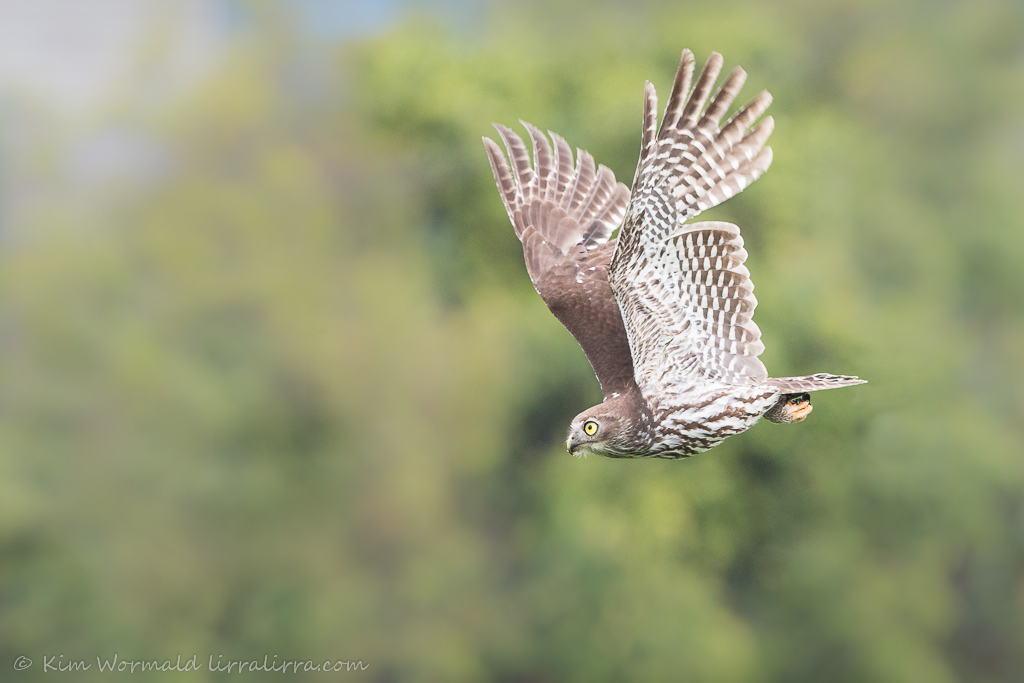Barking Owls are listed as endangered in Victoria and are rarely seen, even at the edge of the dense woodlands which are their preferred habitat let alone flying across a city paddock. This series of images show the owl speeding towards the ground with its wings up, then down, then level.
 Barking Owl (Ninox connivens)
Barking Owl (Ninox connivens)
Canon 5DIII, 400mm f/2.8L IS II USM (test lens), 1/2000, f/5.6, ISO 1600, focal length 400mm
I had the opportunity to take these images and test Canon super tele lenses at an event organised by Jay and Erin from the Canon Collective. About 20 bird photographers gathered near the Melbourne Cricket Ground as the team from Full Flight introduced some of their birds of prey. These images cannot be considered ‘nature’ shots (according to the definition for international competitions which I usually adhere to) because the owl is captive; he was bred as part of a conservation breeding program and the hunt is on to find him a mate. Also, I did some cloning, including removing the leather jesses that dangled from the bird’s legs and cloning is not permitted in nature shots. Whilst I always feel torn when I see birds that aren’t completely free it is comforting to remember that they, like the birds at Healesville Sanctuary, are captive bred or part of a rehabilitation program for injured birds, that they play an important role in educating people about birdlife and that it is their strong bond with their handlers that brings them back after each flight.
The Canon 400mm f/2.8L IS II USM lens weighs just under 4kg but felt well-balanced and I handheld it for these images. The morning was dull which meant I needed a high ISO to get a fast enough shutter speed to try to capture a shot of this fast-flying bird. I could do with more practise!
 Barking Owl (Ninox connivens)
Barking Owl (Ninox connivens)
Canon 5DIII, 400mm f/2.8L IS II USM (test lens), 1/2000, f/5.6, ISO 1600, focal length 400mm
Barking Owls are hawk-owls so they don’t have a heart-shaped face, they are about 40cm and weigh about 700g. They hunt for prey from an exposed branch or from the air and eat a range of small mammals, reptiles, birds and insects. One of the most remarkable things about them is their call, which sounds remarkably like a dog barking, and gives them their name. A few years ago I was on my veranda one evening when I heard one calling, though the person with me (who I won’t embarrass) insisted it was a dog. I called an owl expert in the morning and he put me onto a researcher who had been playing Barking Owl calls a couple of hundred metres from my home. It was a hilarious way to meet a lovely ecologist.

Barking Owl (Ninox connivens)
Canon 5DIII, 400mm f/2.8L IS II USM (test lens), 1/2000, f/5.6, ISO 1600, focal length 400mm
The image above is my favourite of the series. I like that the owl has its bill open and that the shallow depth of field is obvious from the grass that is only in focus for a very narrow band.
Many thanks to Jay, Erin, the birds and their handlers and to John for getting me into the city. I don’t usually go to the city more than once a decade but last week I was there twice, the other occasion was bird-related too in a remarkable way that I’ll share soon.
Happy birding, Kim
~ Thank you for your visit and comments.
~ If you’d like to receive a weekly email informing you that lirralirra has been updated please add your email address to the ‘subscribe’ box above right.

The spread of the primary feathers on the wings is amazing, the tallons look so powerfull even tucked behind her belly, ready for grasping its food.
Love it.
Dean
Your comment about the talons made me look at them more closely; they are amazing. In the first image they look almost as big as the owl’s head. Beautiful birds, I’m glad you like the images – thank you.
OMG what a super cool bird. I didn’t know there was such a thing and your images are super. I’m impressed with how clear they are at the high ISO so thumbs up to that new lens and I’m totally jealous!
Thank you Sherry. I had lots of blurry shots to go with them 🙂
You did a nice job with the flight shots as well as the cloning. Great information about this interesting raptor.
Thank you Julie!
Lovely photos Kim….now that is a lens I would love to own.
Have you put an order in for one?
It is a beautiful piece of craftsmanship Carole. I wish! Have you?
Superb photography (& makes me want that 5D even more)
Thank you Pauli. The 7D2 could be worth putting on your Christmas list.
Simply stunning. Too many owls could never be enough. And I very, very rarely see them.
Megathanks – and I hope with every fibre of my being that a mate IS found for him.
Me too EC, wouldn’t the little ones be precious.